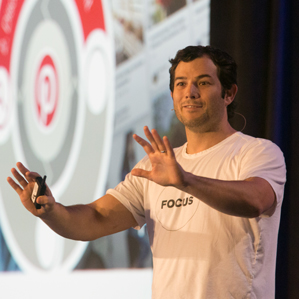EmTech Digital: Pinterest’s Bid to Reinvent Online Shopping
Today people go on Pinterest to populate digital scrapbooks with “pins” that are like bookmarks for items from online stores and other websites. Tomorrow they will also click “buy” buttons embedded next to the recipes, housewares, and clothing they find through the service, potentially making Pinterest a far more influential force in e-commerce.

Tim Kendall, head of partner products at Pinterest, said today that the company was working hard to roll out the new buy buttons and suggested the dominant online retailer Amazon and grocery delivery service Instacart would be the kinds of companies that might benefit. In a talk at MIT Technology Review’s EmTech Digital event in San Francisco, Kendall suggested that the feature could mean that after a discovering a recipe on Pinterest, you could click a button to order the ingredients from Instacart. Likewise, you could spot homewares or clothing on Pinterest and add the items with a single click to your Amazon wishlist or shopping cart.
Kendall said those examples were just hypothetical for now, but that work is underway on a system that will let any company easily add buy buttons to Pinterest. “We want this to be all over Pinterest,” he added.
Pinterest is adding buy buttons as part of the six-year-old company’s intensifying efforts to wring revenue from its more than 70 million users. The company already generates revenue from charging companies for “promoted pins” that are more visible to Pinterest users than other content. But Kendall suggested that the commerce strategy was more important to the company. He was at pains to differentiate Pinterest’s business and service from those of ad-supported social networks such as Facebook and Twitter.
“One of the biggest misconceptions about Pinterest, even by people that use Pinterest, is that we’re a social network,” said Kendall.
Activity on social networks such as Facebook or Twitter is mostly focused on replaying or showing off the past or present, he said. “We’re a tool for you to figure out what you want to do in the future.”
If Kendall is right, Pinterest’s money-making plan would be better aligned with the way people use its service than the revenue models of ad-supported social networks would be. Facebook, for example, has to weave promotional messages amongst updates posted by its users’ friends and family members. In Pinterest’s case, the content itself would effectively double as an ad.
Keep Reading
Most Popular
Large language models can do jaw-dropping things. But nobody knows exactly why.
And that's a problem. Figuring it out is one of the biggest scientific puzzles of our time and a crucial step towards controlling more powerful future models.
How scientists traced a mysterious covid case back to six toilets
When wastewater surveillance turns into a hunt for a single infected individual, the ethics get tricky.
The problem with plug-in hybrids? Their drivers.
Plug-in hybrids are often sold as a transition to EVs, but new data from Europe shows we’re still underestimating the emissions they produce.
Google DeepMind’s new generative model makes Super Mario–like games from scratch
Genie learns how to control games by watching hours and hours of video. It could help train next-gen robots too.
Stay connected
Get the latest updates from
MIT Technology Review
Discover special offers, top stories, upcoming events, and more.